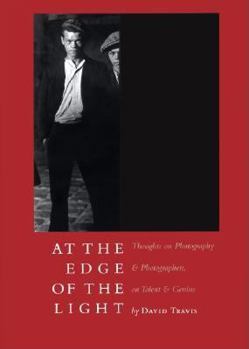At the Edge of the Light: Thoughts on Photography & Photographers, Talent & Genius
Select Format
Select Condition 
Book Overview
Gets to the emotional, technical and aesthetic core of genius at work. In these seven essays Travis presents his thoughts on some of his favourite subjects: Weston, Stieglitz, Kertesz, Brassai and... This description may be from another edition of this product.
Format:Hardcover
Language:English
ISBN:1567922112
ISBN13:9781567922110
Release Date:October 2006
Publisher:David R. Godine Publisher
Length:208 Pages
Weight:1.55 lbs.
Dimensions:0.9" x 6.4" x 8.8"
Customer Reviews
2 ratings
Disciplining the lyrical eye
Published by Thriftbooks.com User , 18 years ago
Whether it's a re-interpretation of Bresson's "decisive moment" or his feeling of strangeness that Kert?sz's Chez Mondrian remained unpublished and unknown for so long; David Travis' seven essays make for an excellent afternoon's read and offers insight into some of the subtle nuances that comprise the gamut of photographic genius. In fact, I found his essay on Kert?sz more interesting for what it said about Mondrian than about Kert?sz himself although it does provide context for his meticulous compositions Chez Mondrian and Mondrian's Pipe and that the Mondrian studio environment may have "helped to discipline [Kert?sz's] lyrical eye." I'm afraid I was less than convinced with the curious relationship of number theory to photographic composition. Particularly the statement attributed to Cantor that "...these two sets form the same size of infinite set.." (an absurdity without dimension) and I switched-off from the details at that point. I did however, enjoy his conjecture regarding the role of the subconscious in both mathematical and artistic creativity and the acknowledgement that inspiration and perspective is often found far away from the perceived comfort of our own artistic discipline. For me this is where the book's title made every sense and on reflection served as it most important lesson. Travis' final three essays offer plausible conjecture into the generational stages of Weston, Stieglitz and Strand not only with regards to the chronology of creative expression as identified by the Japanese tea master Sen no Rikyu but also because there is much within the Rikyu aesthetic that speaks to their latter work. Well recommended!!
A great read
Published by Thriftbooks.com User , 19 years ago
"At the Edge of the Light" is a collection of seven essays on Brassaï, Kertész, metaphors about the parallels between photography and mathematics, the role of narratives in photography, Weston, Stieglitz, and Strand. The first essay on Brassaï covers a long swath of his life, but the parts I found most interesting where those about his relationships with other artists in Paris during the late 1920's and 30's, particularly Henry Miller, and his intellectual influences, such as Goethe and Nietzsche. The best word I can find to describe the narrative and writing in this essay is "pleasant." I particularly enjoyed Travis' description of Brassaï's work as capturing "flow and duration", and contrasting it with Cartier-Bresson's "decisive moment." I found this description of Brassaï's work to be among the best aspects of the book. The second essay deals with Kertész. Although Travis discusses much of Kertész's work during the 1920's, he mainly focuses on the picture "Chez Mondrian," Kertész's relationship with Mondrian, and even much on Mondrian himself. While I did enjoy this essay, I didn't take as much away from it as the others. The third essay was by far my favorite, not just because it is about the relationship between mathematics and photography and I am a mathematician, but because it is genuinely deep and novel. Travis discusses the creative process in photography through metaphors with mathematical reasoning and proof in the (relatively) accessible field of number theory, even going so far as to proclaim that "there is no difference in the way a creative idea comes to a mathematician and the way one comes to a photographer." Although most of the metaphors are just that, and effectively so, the comparison between Euclid's proof of the Pythagorean Theorem and Cartier-Bresson's "Hyères, France" approaches a true bijection. This example was my absolute favorite part of the book. Travis goes further and explains the role of beauty and aesthetics in mathematical creativity, drawing upon Hadamard's "The Psychology of Invention in the Mathematical Field." Here Travis also gets into the role of the subconscious in both mathematical and artistic creativity. A respected curator of photography, especially at a place like the Art Institute of Chicago, going off and studying mathematics, and then coming back and teaching so much about photography, has to be one of the most remarkable intellectual exercises I have every encountered. The fourth essay deals with how the presence or absence of narratives in photography affects our experience of the artwork. This leads to the primary discussion of the last three essays on artists in old age. Travis tries to show the importance of the later work of Weston, Stieglitz, and Strand, and the tenor of his arguments are summed up in one he makes about Strand: "What then is there to say about a photograph of an autumn leaf, especially one in black and white? Beyond some diagram of composition,





